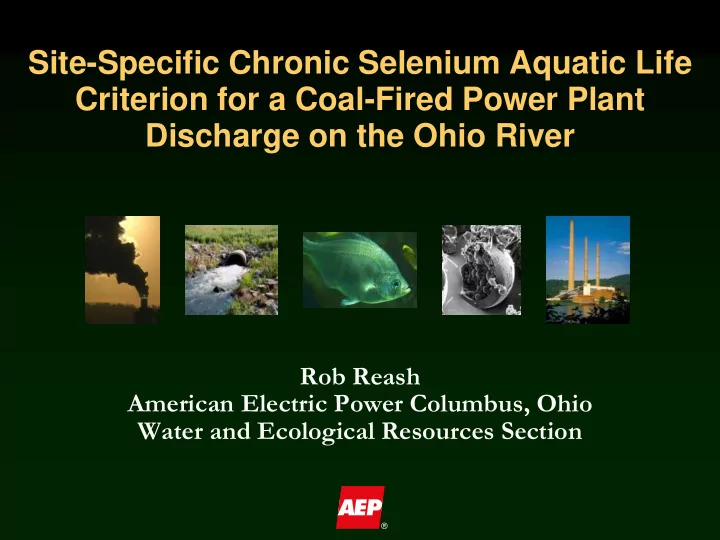

Site-Specific Chronic Selenium Aquatic Life Criterion for a Coal-Fired Power Plant Discharge on the Ohio River Rob Reash American Electric Power Columbus, Ohio Water and Ecological Resources Section
Objectives Assess Se bioaccumulation in a simplistic food chain (water → periphyton → forage fish → piscivore) in a high-exposure setting. Evaluate methods to determine a potential site-specific Se water criterion.
Mountaineer Plant Located on Ohio River near New Haven, WV. 1,300 MW facility w/ SCR, wet FGD, and demonstration-scale carbon capture w/underground injection. FGD WWTP fitted for phys-chem processes and organo-sulfide for enhanced Hg removal. ABmet selenium bioreactor operational late 2011. Must meet average Se WQBEL of 33 µg/L by 7/2011.
Methods Collection of forage and piscivore fish in acute mixing zone (known fish concentrator); 2010 and 2011. Analysis of total Se, As, and Hg, and MeHg, in whole body (forage fish), fillet, and/or ovary samples. Trace metal analysis of periphyton samples. Chemical analysis of mixing zone and reference water samples.
Expected New Se Water Quality Criteria Water criteria: 2.3 µg/L for lake/lentic waters. 3.9 µg/L for running waters. Reasonable potential is likely even if you discharge very low levels. Ovary criterion ~17 mg/Kg. Permitting issue: if agency determines RP based on water criterion and places Se WQBEL, you need a mechanism to remove the WQBEL if ovary criterion is attained.
Water Analysis Results (mean values) Parameter Reference Mixing Zone As ( µg/L) 0.9 5.6 Se ( µg/L) < 0.3 23.6 Zn ( µg/L) 4.2 13.5 Al (mg/L) 0.30 1.1 Hardness 136 814 (mg/L) TDS (mg/L) 261 1,522 Sulfate (mg/L) 81 458 pH (s.u.) 7.97 8.26
Periphyton Analysis Results Sept 2010 sampling : ● Mixing zone samples w/elevated levels of Cu, Mg, Mo, Ni, Se, Tl. Avg [Se] = 8.14 mg/kg dry wt. BCF = 509 (mixing zone); 735 (reference) Oct 2011 sampling: ● Mixing zone samples w/elevated levels of Mo, Se, Tl. Avg [Se] = 24.4 mg/kg BCF = 1,061 (mixing zone); 4,567 (reference) For both sampling events, levels of Hg in reference samples were higher.
Forage Fish Analysis Results Species: channel shiner/emerald shiner mix Tissue analyzed: whole body composites. Reference avg [Se] = 2.25 mg/kg dry wt. Mixing zone avg [Se] = 3.70 mg/kg BAFs (periphyton → forage fish): 1.64 (reference) and < 1 for mixing zone.
Piscivore Fish Tissue Results April 2010 Species Tissue Reference Mixing Se (mg/kg) zone Se (mg/kg) HSB Ovary ---- 23.1 Fillet 4.23 12.2 Bluegill Ovary ---- 3.80 Fillet 3.0 2.99
Piscivore Results (cont.) August 2010 species: sauger tissue analyzed: fillet reference avg [Se] = 3.2 mg/kg mixing zone avg [Se] = 3.4 mg/kg
Piscivore Results (cont) October 2011 Species Tissue Reference Mixing Se (mg/kg) zone Se (mg/kg) Bluegill Whole ---- 5.0 body Fillet 3.1 ---- HSB Fillet 2.8 6.8 Sauger Fillet 2.4 2.4
Calculation of Site-Specific Se Criterion to Protect HSB C water = C predator / (BCF algae X TTF cons X TTF pred ) C water 17 mg/kg (EPA ovary criterion) (509 L/kg X 0.1 x 6.2) = 53.9 µg/L
Conclusions – Fish Tissue Results No evidence of bioaccumulation risks to bluegill and sauger. HSB may be at risk of Se bioaccumulation. HSB ovary [Se] exceeds anticipated EPA ovary criterion, however is only slightly higher than LMB reproductive threshold (21 mg/kg). HSB have HIGH growth rate (all fish collected for Se analysis were either age 1+ or 2+).
Conclusions Se bioaccumulation risks must be assessed species-by-species Periphyton (also true of algae) Kd value is most variable and may not be needed. In this study, only HSB had tissue levels of concern. Whatever method is used to derive a SS criterion, trophic relationships must be understood; important for understanding routes of exposure.
Thank you for your attention Questions?
Recommend
More recommend